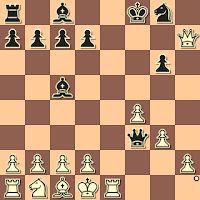Tran Nguyen Duy Tung - PAGunko
10 0 blitz, internet, 2021
1.e4 e5 2.Nf3 Nc6 3.Bc4 Nd4
The Blackburne Shilling Gambit. White now has several playable responses, including 4.Nxd4, 4.c3, 4.d3, and 4.0-0. He should avoid what Black wishes, 4.Nxe5 Qg5.
Of course, those familiar with the Jerome Gambit (1.e4 e5 2.Nf3 Nc6 3.Bc4 Bc5 4.Bxf7+) might want to "Jerome-ize" the opening.
4.Bxf7+
As I posted earlier
To learn about the line, it is useful to progress through the following blog posts, in order, from oldest to more recent: "Blackburne Shilling Jerome Gambit 2", "Why, I oughta...", "Clearly Unclear", "Untangling Lines of Play", " 'Even' does not mean 'safe' ", "Whose Territory Are We Fighting On?", "Starting Over", "Not-So-Instant Victory", "More Updating", "A High Level of Danger", "Blackburne Shilling Gambit: Don't Feed the Greed", and "Caught Out".
4...Kxf7 5.Nxe5+ Ke6 6.Qh5
And, again, from an earlier post
If you are going to play 6.Qh5, here are a few guidelines from past posts: "Read This Blog", "Scared to Death" ,"Greed Is Not Good" and "Is Still Not".
My preference is 6.c3, and I am surprised to see that Stockfish 14.1 now prefers 6...Nc6 instead of 6...Kxe5.
However, White intends to offer further material, and in a blitz game, when things are unclear and analysis can go only so deep, it is often tempting to grab stuff.
6...Nxc2+
With 6...Nf6 Black would be clearly better (up 2 pieces) and although White could cloud the situation with 7.Qf7+ Kxe5 8.f4+, but it should not work.
7.Kf1
Stockfish 14.1 much prefers 7.Kd1, with a strange line of play that limits White's deficit: 7...Nf6 8.Qh3+ Kxe5 9.d4+ Kd6 10.e5+ Kc6 11.Qc3+ Kb6 12.Qxc2 c6 13.exf6 Qxf6.
However, if White wants to convince Black that White's opening has failed and he is in panic, this move does the job.
7...Nxa1
White is now better and actually has a forced checkmate. He misses the most direct line, but - with the help of his opponent - gets to checkmate another way.
8.Qf5+
Strong enough. Even more generous would have been 8.Qf7+ Kxe5 9.d4+ Kd6 10.Na3 c5 11.Bf4+ Kc6 12.Qd5+ Kb6 13.dxc5+ Bxc5 14.b4 Qf8 15.bxc5+ Qxc5 16.Nc4+ Ka6 17.Qxc5 b6 18.Qa3+ Kb7 19.Na5+ bxa5 20.Ke2 Nc2 21.Rb1+ Nb4 22.Qxa5 Kc6 23.Rc1+ Nc2 24.Rxc2+ Kb7 25.Qb5 checkmate
8...Ke7
Leads to checkmate.
Of course, 8...Kd6 would lose the Queen to 9.Nf7+ Ke7 10.Nxd8.
9.Qf7+ Kd6 10.Nc4+ Kc5 11.Qd5+ Kb4 12.a3+ Kb3 13.Qb5+ Kc2 14.Nc3 c6 15.Ne3+ Kxc1 16.Ke2 checkmate
Very pretty.





































